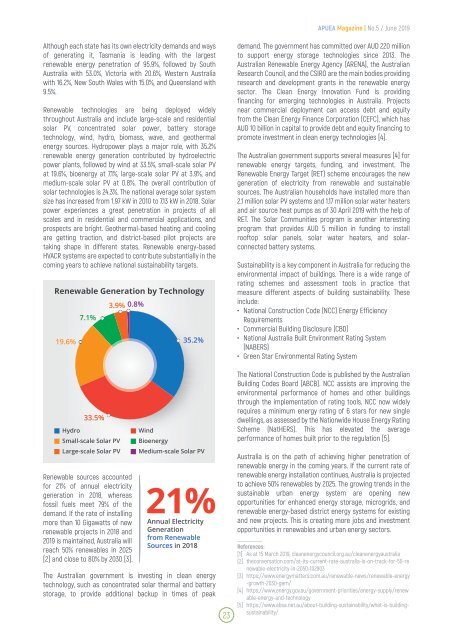APUEA Magazine-no.5 June 2019
You also want an ePaper? Increase the reach of your titles
YUMPU automatically turns print PDFs into web optimized ePapers that Google loves.
<strong>APUEA</strong> <strong>Magazine</strong> | No.5 / <strong>June</strong> <strong>2019</strong><br />
Although each state has its own electricity demands and ways<br />
of generating it, Tasmania is leading with the largest<br />
renewable energy penetration of 95.9%, followed by South<br />
Australia with 53.0%, Victoria with 20.6%, Western Australia<br />
with 16.2%, New South Wales with 15.0%, and Queensland with<br />
9.5%.<br />
Renewable technologies are being deployed widely<br />
throughout Australia and include large-scale and residential<br />
solar PV, concentrated solar power, battery storage<br />
technology, wind, hydro, biomass, wave, and geothermal<br />
energy sources. Hydropower plays a major role, with 35.2%<br />
renewable energy generation contributed by hydroelectric<br />
power plants, followed by wind at 33.5%, small-scale solar PV<br />
at 19.6%, bioenergy at 7.1%, large-scale solar PV at 3.9%, and<br />
medium-scale solar PV at 0.8%. The overall contribution of<br />
solar technologies is 24.3%. The national average solar system<br />
size has increased from 1.97 kW in 2010 to 7.13 kW in 2018. Solar<br />
power experiences a great penetration in projects of all<br />
scales and in residential and commercial applications, and<br />
prospects are bright. Geothermal-based heating and cooling<br />
are getting traction, and district-based pilot projects are<br />
taking shape in different states. Renewable energy-based<br />
HVACR systems are expected to contribute substantially in the<br />
coming years to achieve national sustainability targets.<br />
Renewable Generation by Technology<br />
3.9% 0.8%<br />
7.1%<br />
19.6%<br />
33.5%<br />
Hydro<br />
Small-scale Solar PV<br />
Large-scale Solar PV<br />
Renewable sources accounted<br />
for 21% of annual electricity<br />
generation in 2018, whereas<br />
fossil fuels meet 79% of the<br />
demand. If the rate of installing<br />
more than 10 Gigawatts of new<br />
renewable projects in 2018 and<br />
<strong>2019</strong> is maintained, Australia will<br />
reach 50% renewables in 2025<br />
[2] and close to 80% by 2030 [3].<br />
35.2%<br />
Wind<br />
Bioenergy<br />
Medium-scale Solar PV<br />
21%<br />
Annual Electricity<br />
Generation<br />
from Renewable<br />
Sources in 2018<br />
The Australian government is investing in clean energy<br />
technology, such as concentrated solar thermal and battery<br />
storage, to provide additional backup in times of peak<br />
23<br />
demand. The government has committed over AUD 220 million<br />
to support energy storage technologies since 2013. The<br />
Australian Renewable Energy Agency (ARENA), the Australian<br />
Research Council, and the CSIRO are the main bodies providing<br />
research and development grants in the renewable energy<br />
sector. The Clean Energy Innovation Fund is providing<br />
financing for emerging technologies in Australia. Projects<br />
near commercial deployment can access debt and equity<br />
from the Clean Energy Finance Corporation (CEFC), which has<br />
AUD 10 billion in capital to provide debt and equity financing to<br />
promote investment in clean energy technologies [4].<br />
The Australian government supports several measures [4] for<br />
renewable energy targets, funding, and investment. The<br />
Renewable Energy Target (RET) scheme encourages the new<br />
generation of electricity from renewable and sustainable<br />
sources. The Australian households have installed more than<br />
2.1 million solar PV systems and 1.17 million solar water heaters<br />
and air source heat pumps as of 30 April <strong>2019</strong> with the help of<br />
RET. The Solar Communities program is another interesting<br />
program that provides AUD 5 million in funding to install<br />
rooftop solar panels, solar water heaters, and solarconnected<br />
battery systems.<br />
Sustainability is a key component in Australia for reducing the<br />
environmental impact of buildings. There is a wide range of<br />
rating schemes and assessment tools in practice that<br />
measure different aspects of building sustainability. These<br />
include:<br />
•<br />
•<br />
•<br />
•<br />
National Construction Code (NCC) Energy Efficiency<br />
Requirements<br />
Commercial Building Disclosure (CBD)<br />
National Australia Built Environment Rating System<br />
(NABERS)<br />
Green Star Environmental Rating System<br />
The National Construction Code is published by the Australian<br />
Building Codes Board (ABCB). NCC assists are improving the<br />
environmental performance of homes and other buildings<br />
through the implementation of rating tools. NCC now widely<br />
requires a minimum energy rating of 6 stars for new single<br />
dwellings, as assessed by the Nationwide House Energy Rating<br />
Scheme (NatHERS). This has elevated the average<br />
performance of homes built prior to the regulation [5].<br />
Australia is on the path of achieving higher penetration of<br />
renewable energy in the coming years. If the current rate of<br />
renewable energy installation continues, Australia is projected<br />
to achieve 50% renewables by 2025. The growing trends in the<br />
sustainable urban energy system are opening new<br />
opportunities for enhanced energy storage, microgrids, and<br />
renewable energy-based district energy systems for existing<br />
and new projects. This is creating more jobs and investment<br />
opportunities in renewables and urban energy sectors.<br />
__________<br />
References:<br />
[1]<br />
[2]<br />
[3]<br />
[4]<br />
[5]<br />
As at 15 March <strong>2019</strong>, cleanenergycouncil.org.au/cleanenergyaustralia<br />
theconversation.com/at-its-current-rate-australia-is-on-track-for-50-re<br />
newable-electricity-in-2050-102903<br />
https://www.energymatters.com.au/renewable-news/renewable-energy<br />
-growth-2030-gem/<br />
https://www.energy.gov.au/government-priorities/energy-supply/renew<br />
able-energy-and-technology<br />
https://www.absa.net.au/about-building-sustainability/what-is-buildingsustainability/




